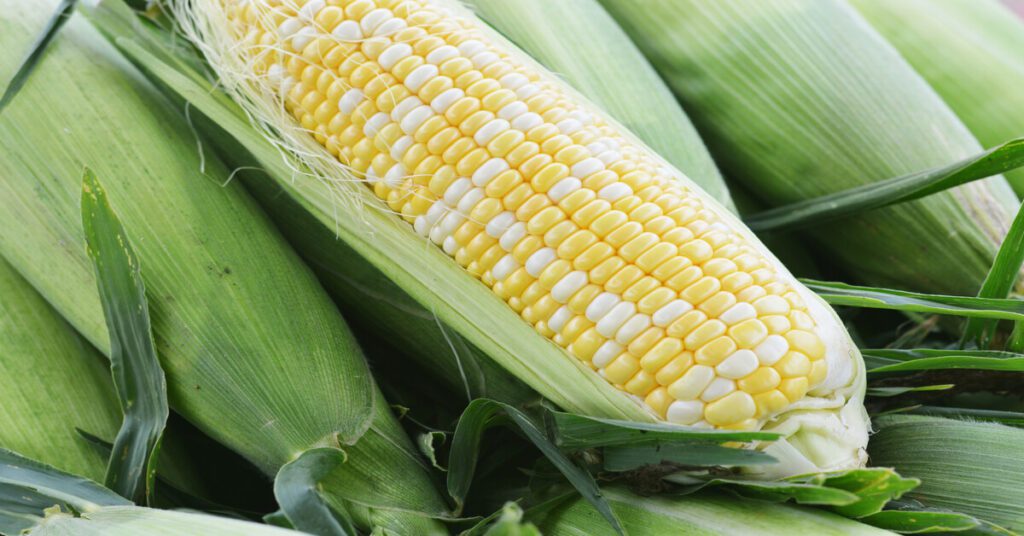Is Corn man-made? Corn (Zea mayssubs. mays) or maize does not grow naturally in the wild and requires human cultivation.
Humans have been selectively cultivating corn for thousands of years. Resulting in the thousands of different varieties of corn we know today.
Due to this selection, the corn husk completely surrounds the tightly-packed kernels. Making it impossible for seeds to naturally fall to the ground and germinate.
Corn is incredibly hardy. Protected from moisture, corn can survive intact for centuries.
Corn is part of the grass family (Poaceae). Which has over 780 genera and 12,000 species. Including the grass on your front lawn and staple foods such as wheat, rice, and barley.
The origin of corn is as complex as are the myths associated with it.
Origins of Corn
It is widely believed that corn originated in southwestern Mexico over 8,700 years ago. Genetic analysis then showed it diffused south to Peru and north to the Southwestern U.S.
Remains of corn pollen have been identified in fossil records in Panama from 6,900 years ago. As well as in Ecuador from 6,000 years ago. [1]
How was corn created?
In the 1930s, American geneticist George Beadle hypothesized that corn came from teosinte, a wild species of grass.
He concluded this after successfully breeding teosinte with an Argentine varietal of corn to recreate primitive small-ear corn found at archeological sites.
American botanist Paul Mangelsdorf proposed another theory. That corn developed from a combination of wild grass called Tripsacum and a now extinct wild maize.
In the 1990s, biologist Mary Eubanks was able to create a primitive hybrid in the lab. By crossing a rare maize relative with a cousin species of grass. This combination, she admitted, is unusual and probably did not occur naturally. [2]
The ancient Mayans believed that corn was a gift from their gods to humankind. And is the same material upon which people are made.
Varieties of Corn
Corn is one of the most diverse varieties of grain crops found in nature.
Selective breeding by humans and nature has resulted in various types of corn. Classified by the tissue that surrounds the corn’s kernel (endosperm).
These classifications are flint, flour, dent, pop, sweet, waxy, and sometimes pod.
Pop (Z. mays everta) and flint corn (Z. mays indurata), for example, have hard endosperm and are used for making popcorn.
Dent corn (aka field corn; Z. mays indentata), the most common corn grown in the United states, is often used as livestock feed. Or in industrial products and processed foods such as corn chips, tacos, and tortillas.
Sweet corn (Z. mays saccharata) is primarily eaten on the cob or canned and frozen.
Flour corn (Z. mays amylacea) is used in baked goods and for making corn flour.
Is corn a GMO?
GMOs are defined as an organism whose DNA has been modified in the lab to express different flavors and genes.
According to the FDA, most (~92%) of the corn crop commonly grown in the United States is derived from genetically engineered seeds (GMOs). That were created to repel insects or tolerate herbicides.
Bacillus thuringiensis (Bt) corn is a type of corn that has been modified to naturally include proteins. That ward against harmful insects. But are entirely safe to pets, humans, and beneficial insects such as ladybugs.
While GMOs are present in corn, the vast majority goes into processed foods and drinks. Or used to feed livestock. [3]
According to the FDA, GMO foods in the U.S. are safe and undergo rigorous studies. To prove they do not affect people differently than non-GMO foods before being sold to the public.
References:
[1] Maggioni, L., von Bothmer, R., Poulsen, G., & Branca, F. (2010, March 31). Origin and Domestication of Cole Crops (Brassica oleracea L.): Linguistic and Literary Considerations. Economic Botany, 64(2), 109–123. https://doi.org/10.1007/s12231-010-9115-2.
[2] Jones, M. O. (2017, December 15). Corn: A Global History (Edible). Reaktion Books.
[3] Center for Food Safety and Applied Nutrition, (2022, August 3). GMO Crops, Animal Food, and Beyond. U.S. Food And Drug Administration. Retrieved October 17, 2022, from https://www.fda.gov/food/agricultural-biotechnology/gmo-crops-animal-food-and-beyond.

